After almost two decades of chicken keeping, I finally had a case of bumblefoot in my flock. Sometimes bumblefoot is due to getting a splinter or a cut in the bottom of the foot. Typically, bumblefoot occurs when a heavy hen injures herself jumping off of a roost. All of this leads to a infection inside the pad of the foot which results in severe swelling and pain. If the injury isn’t attended to, the infection can spread up the leg and kill the bird.
Of course, it wasn’t one of my heavy and older hens that got bumblefoot. It was lithe and skinny Tina, which shows that there’s always an exception to the rule. She wasn’t limping too badly, but the swelling was hard to miss.
Inspection of the underside showed a scab, or plug.
A trip the vet would have cost several hundred dollars, which in all honesty, I am not willing to spend on Tina. Besides, the travel and anesthesia would have been stressful for her. I decided to take care of this on my own. I got out my chicken medicine kit. I pulled on some disposable gloves – the infective agent is usually a staphylococci bacterium, something that, if accidentally ingested, could do me harm.
No one was home, so I had to do this one-handed. (Which also limited the ability to take photos during the operation!)
I held Tina in one arm, snug against me, holding the foot with my left hand. In my right hand I wielded sharp tweezers. With a bit of twisting and digging, I pulled off the plug. I was surprised that only a trickle of gunky liquid oozed out. I squeezed. Nothing. I inserted the tweezers into the now open hole and felt around. Meanwhile, Tina was more annoyed at being held than at what I was doing to her foot. She only squawked once during this entire operation. The tweezers found a hard solid mass which I grabbed with the sharp tips and pulled out. It was a lump the size, shape and hardness of a peanut. With more probing and poking, I pulled out a second one. My guess is that these are a combination of infected fluids and tissue that solidified, rather like a pearl in an oyster building up in layers.
I rinsed out the foot with running water. I generously squirted a broad spectrum antibiotic ointment (purchased from the vet for an injury some time ago), into the hole. I covered the pad with a strip of clean bandage, and held it all on with duct tape. I used dark brown duct tape – the silver encourages pecking. I put Tina back into the pen with the other hens. After a couple of funny struts and a peek at her bandaged foot, she walked off, looking as normal as Tina ever looks. That evening she roosted with the others.
I changed her bandage the next day, and although there was still some swelling,
the foot looked deflated. I bandaged her up again, and even with cotton and duct tape attached, Tina walked without hesitation or limp.
Two days later I removed the bandage and soaked Tina’s foot in a warm epsom salt bath. (I used a half-cup of epsom salts in the tub.) I did this to draw out any remaining infection and to deep clean the foot. It was easiest to soak Tina, too, and she seemed to like it. She settled right in.
There was still some swelling in her foot, and the hole was open so I poked around with the tweezers, but didn’t find anything nasty inside.
I squirted in some more antibiotic ointment and bandaged her once more. That bandage fell off two days later and upon inspection, the foot pad appeared healed. I let it be.
A week later the foot seems healthy again. Compare it to the other foot. There’s nothing pretty about chicken feet, especially on older hen’s dirty, scaly, lumpy feet. But, having seen this foot ballooned up with infection, it looks darn good now.
I’ve talked with others who have more experience than I with bumblefoot. Some chickens get recurring infections. Some, despite surgery, never recover. I hope that I don’t see a case for another two decades. But if I do, I hope I’ll be as successful treating it as I was this time around.

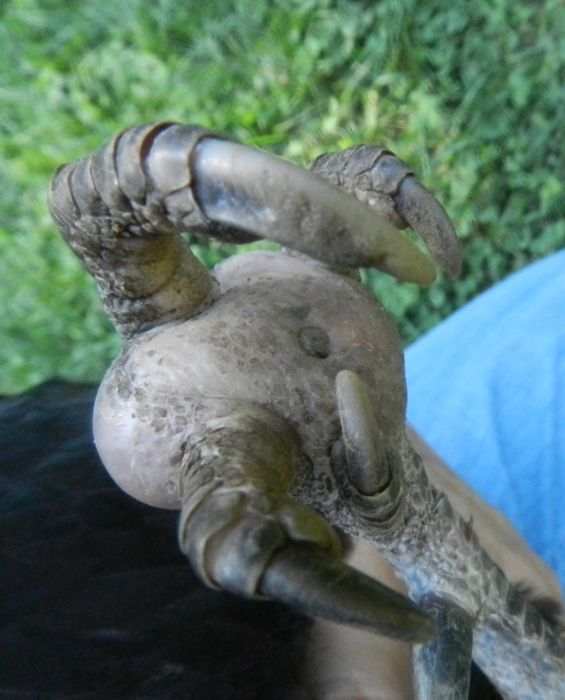
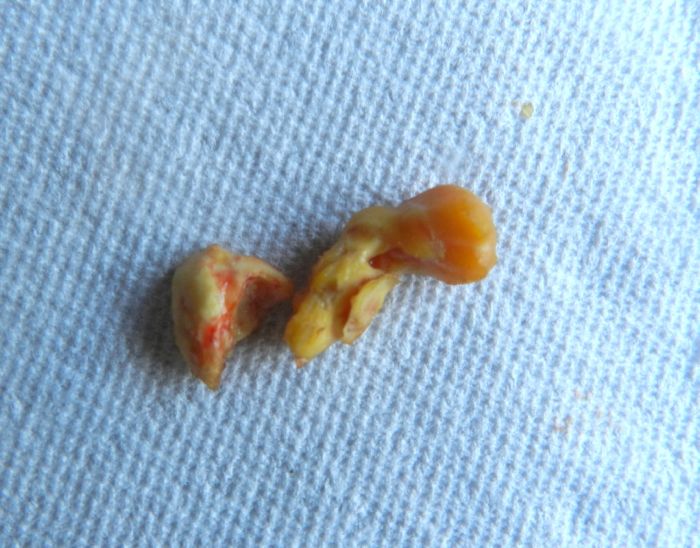

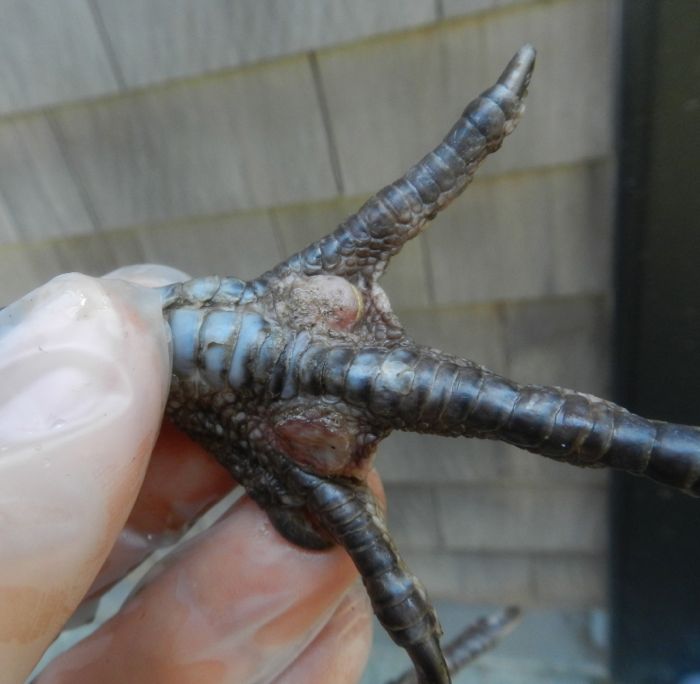

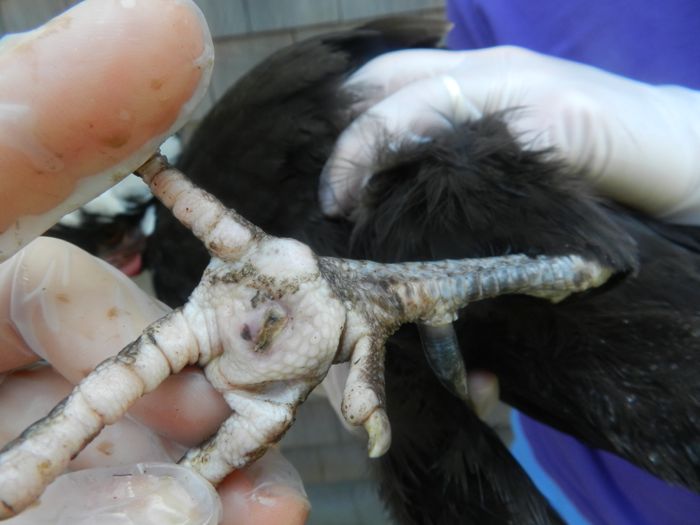
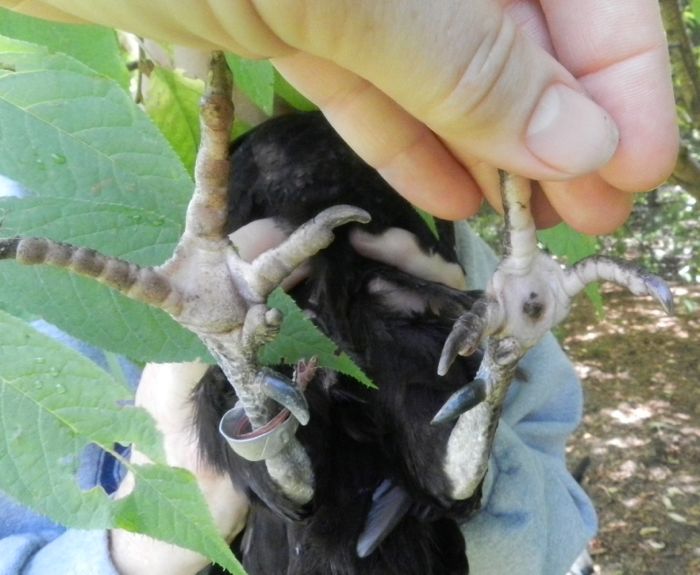

oh.my.stars…that is so amazing! I so enjoy watching your chickens!
I plan on getting chickens next spring. I’ve had them in the past and lost them due to coyotes who sneaked in.
Your blog has inspired me and taught me so much. I very much thank you for sharing your knowledge about the care of chickens.
Glad Tina recovered!
Thanks for sharing this with us – I’ve heard lots of chatter about bumblefoot lately and I finally feel like (for the first time) that I actually KNOW what to keep an eye out for and how to deal with it if it ever happens. I really appreciate all of your posts on chicken medical issues. We’ve never had anything major happen in our flock, but through your posts I feel prepared in case something ever does.
Thank you for this. I’ve heard and read about bumplefoot, but had never seen. Now feel that if/when my chickens have it I’ll have some confidence in what to do.
Glad Tina is doing so well!
Congratulations on a successful operation. For me your post is very educational and I so appreciate your sharing that experience, in case I have to deal with it in the future. I was surprised there wasn’t a lot of bleeding involved when you first “pulled the plug.” Those things you pulled out – do you think they were debris that worked their way into the foot, or did her system make them, perhaps as a defense to a foreign object?
I think that those masses were infected fluids and tissue that solidified. Possibly a bit of foreign material was the seed – rather like pearls in oysters. I’ve seen similar masses inside the body cavity of hens. It seems to be what happens in them.
Ouch, poor baby. Thank you again.
Very timely for me – we just had our first case of bumblefoot the other day. We isolated ours but now see that we could probably put her back in with the proper bandage. We used vetwrap and she has not tried to take it off. Thanks so much for the detailed look at your experience!
If I can leave a sick or injured hen in with the others, I do. As long as she’s eating, drinking, not contagious and not being bullied, it’s best for them (and you!) to be with their flock. Otherwise, you’ll have pecking issues to deal with when you reintegrate. Also, sunshine and exercise keeps them healthy.
Terry, you truly can do it all! I have a friend who had a hen with the same problem. It took three of ’em to do the procedure at home. And good for Tina, don’t let anyone know when you’re ‘down.’
Fascinating, Terry, and as always, very helpful. Hope I never have to use this tip, but glad you’ve shared your experience in case the need arises. I so appreciate your practical and sensible approach to chicken keeping. It keeps me more level-headed and far less panicky when the big chicken challenges have presented themselves.
She did have a bad case.
Getting the plug or core is always the hard part. The first time I performed the procedure I was sure with some pressure on the foot that the most awful of stuff would come flying out but no.
Terry I did not realize that I could be harmed by the bacteria! I will glove up next time. Thanks
I’ve read it’s the same staph that people can get. Worth being careful.
good information and pictures…thank you, Terry!
Thank you, Terry, for the oh-so-valuable lesson. And thank goodness you weren’t able to take pictures of the entire tweezy process. I think that with this post you will help many a chicken to recover from the evil bumble.
You rock, girl.
No one has asked just what were the peanut sized objects?
What is it called when their legs get all hard and super scaly?
My old hens’s legs get saggy and scaly and a tad bloated. It’s just age. There’s no name for it. That’s not the same as scaly leg mite.
Did you figure out what those gross hard things were? Kinda looked like bits of hard corn like what you see in hen scratch and then stuff grew on to it.
Thank you for that, the photos are a big help. Hope I don’t have to ever deal with it, but at least I feel better about it having seen it in “real life”.
i’ll be honest, i don’t know that i could do that. let’s pray that my girls feet never get ‘bumbled!’ eww.
i’m happy that tina is back to her old self. she makes me laugh prancing around on camera.
Wow! You should get an honorary vet degree. And put me down for a pre-order of your chicken healthcare book, please. (hint, hint)
Thanks so much for sharing! I would have done the work on the hen myself also. You gave such great detailed picture and Tina is a pretty hen. What type is she, Lauren? Again, very informative and good to know!
Tina and Siouxsie are Polish Crested hens. They’re pretty, ditsy and seriously dim-witted.
Good to know. My daughter is a nurse so I make her do the procedures we can at home. She has had great success with wounds on our cats and we are huge fans of Vetricyn (sp?). Works like magic.
Anything more serious, and I’d have appreciated a nurse!
I agree Elaine, the new medicine everyone is talking about is Vetricyn. I’ve used it on my girls and it did seem to speed up the healing a bit. I still like going in and getting that plug out ASAP when I find one. I’ve only had one that swollen, a Cochin Rooster. Loved that fellow. I actually did take him to the vet, had the toe cut off to try and save him. After $500 in vet bills, lost him. Learned a good lesson to check my girls regularly, especially the feathered feet girls. I’m always giving someone a foot wash to make sure they are ok.
To answer your queries – I’m not exactly sure why or how that yellow lump forms, but my guess is that it had been infected body fluid/pus that solidified. I’ve seen similar material inside of hen’s reproductive tracts (big enough and it causes impactions.)
Wow! You’re amazing Terry. I am thoroughly impressed. I know you are always watching and checking your animals but this is an amazing account. I am not brave enough to do anything like you did. You offered some great tips for hen keepers to keep in mind in case this happens to their ends. Meanwhile, Tina is much improved and it does not seem that she was picked on by the other gals. I’m glad it had a happy ending. Appreciate you sharing this with us.
Wow, that looked gross but I appreciate you sharing your procedure and treatment. I know it feels wonderful to have a successful outcome.
Hi Terry, thank you so much for another helpful post! Is bumblefoot generally accompanied by other signs of infection (swelling, redness, limping), or can it appear as a flat scab or callus with no other symptoms?
Despite that obvious swelling, Tina didn’t show signs of discomfort. But some hens will limp. The foot will be swollen and possibly hot to the touch. If there’s a just a callus or flat scab it’s not bumblefoot and I’d leave it be. BTW, I once had a hen that had a feed pellet stuck in her foot’s webbing. Went right through. I had to pull it out and it left a hole, but it never swelled up or became infected.
I so appreciate your response, Terry. In the total absence of redness / swelling, I hesitate to risk making things “angry.” All my best to Tina!
Poor Tina, glad to hear though that she came out okay. She must have stepped on something, and maybe gotten a infection that way. Those puffy feathers really do block their views, will you be giving Tina and Siouxsie some feather cuts soon so they can see a little better ?
I know I read and seen bumblefoot in several cases of eagles and other wild birds that had to be taken care after they had been injured by humans or by cars. I know in those cases, they really have to bandage the legs well, other wise the birds will just tear it off with those really shap beaks. I guess it’s a good thing Tina is a bit daft, a smarter hen might have fought to tear it off all the time.
Great post! Can I just say wow at those hen spurs!
Did it hurt Tina to have you digging in her foot or do chickens not have feeling in their feet? They go out in thecold with no problem. As you might be able to tell……I know nothing about raising chickens but I follow your blog every day and enjoy it.
As far as I can tell, chickens have a high tolerance for pain. I’ve had chickens with horrible wounds that didn’t seem to notice. But, they also hide weakness, which is something prey animals do, so it’s hard to tell. A frightened chicken will “play dead” (think possum.) While doing the procedure, Tina remained calm and only flinched once, so I don’t think that it was painful or stressful. She certainly enjoyed the epsom salt soak, so I know that didn’t sting. I am sure that the amount of time it took (minutes) was brief, so if there was pain, it was short-lived. Once done she showed no soreness in gait. Chickens have remarkable capacity to rebound from injury.
Love these posts! really fascinating!
Thanks so much for sharing it.
I don’t have chickens yet:( but i’m getting quit an education from your site.) If it wasn’t for watching your video some time ago, on how to pick up chickens carefully, I don’t think I would have been able to save a bird at the beach the other day! From a distance iInoticed these two big dogs (with there owner attached) barking loudly in the face of a bird(a muerre) the bird just stood there.Finally they moved on.The bird was standing there.. in fear. Shortly families were coming up to him,kids were touching him.it really wasn’t a pretty sight.( I felt something was wrong) and then a couple of seagulls started poking at him,I had to do something.the poor guy couldn’t fly away, and they’re not small birds.So, with my towel in hand I rushed over with lots of confidence and picked him up carefully tucking in his wings-keeping his beak away and after a few squaks he was calm.My 13 yr old son called animal resue control and 20 min later he was in better care! Teri one person can make a difference.The information you provide encourages,educates,motivates us all to be better stewards of the planet!
Thank you for sharing this story. It made my day. And thank you for saving that bird and getting it the care it needed.